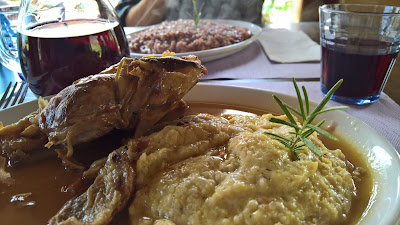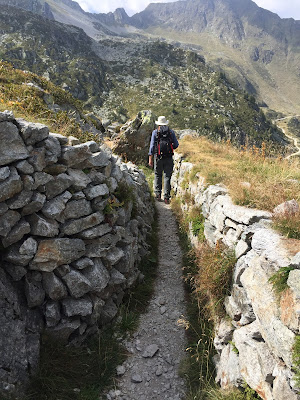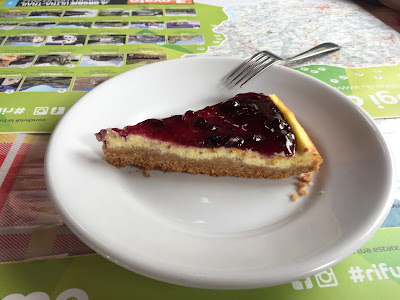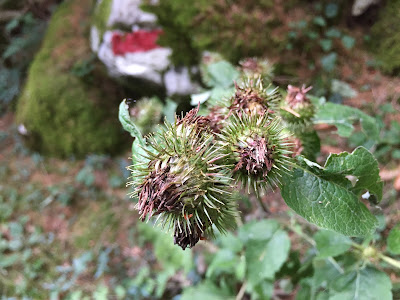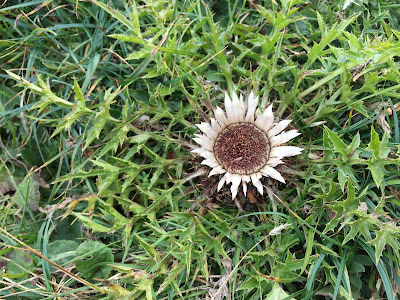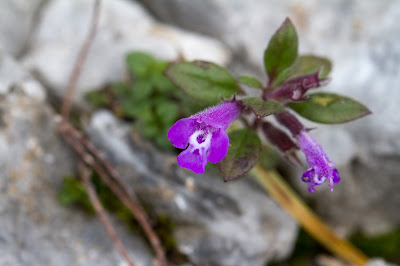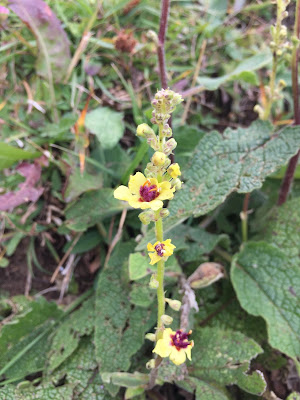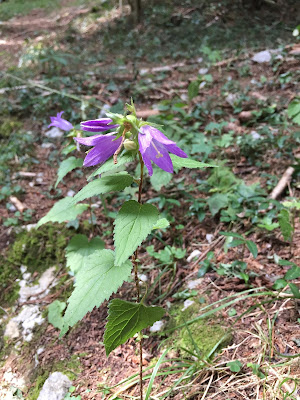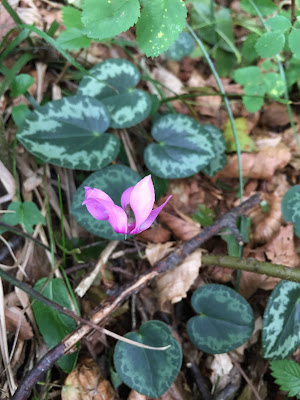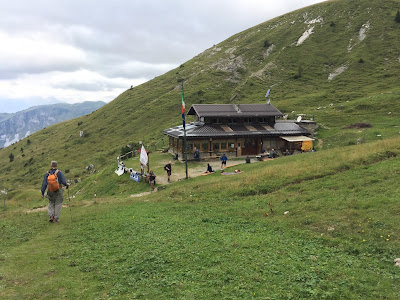
 Left: Route from Foppolo to Lago Moro. Right: View from above Lago Moro looking north toward Monte Disgrazia.
Left: Route from Foppolo to Lago Moro. Right: View from above Lago Moro looking north toward Monte Disgrazia.
Overview
Length: 11 km (6.8 mi)
Duration: ~ 5.25 hours walking time, 1.25 hours before lunch, 4 hours after lunch
Elevation: 1625 m (5,330 ft) @ Foppolo, 2500 m (8,200 ft) @ above Lago Moro. Total elevation gain of 1026 m (3360 ft).
Location: Italy, Lombardy, Alta Valle Brembana
The Town
Foppolo is a small village located 60 miles north of Bergamo in the upper Val Brembana. In winter, it is one of the most important ski centers in the
Bergamo Alps. You can reach Foppolo by bus from Bergamo in about two hours, which is how we got there. From Bergamo, take Linea B (for Brembana) to Piazza Brembana and then transfer to the bus heading for Branzi-Carona-Foppolo.
The location around Foppolo is spectacular: the mountains are beautiful and the views, when you get up high, are some of the best we’ve seen. However, it is primarily a ski-town, and ski-towns
can (and in this case did) have a number of things against them from a hiker’s point of view.
First, there’s the architecture. Foppolo’s architecture – dedicated to skiing – is a combination of atrocious and bizarre, with hotels resembling part chalet, part bunker, and part high-rise prison. We stayed in one of these places one night and the service and accommodations were great, just that their outsides are brutal looking. Secondly, hiking on or near ski slopes in the summer is always a delusion for us. The slopes look like war zones in the summer. The chaotic, bedraggled looking slopes was admittedly softened by the pasturing cows and the sounds of their bells. In the summer, the cows rule the slopes!
To make matters worse, the slopes above Foppolo are in the midst of a massive-but-halted construction of a new gondola. Huge pits were dug for support beams and then stopped. The future of the gondola at time of writing is uncertain due to funding.


 Left: Cows on the ski slopes above Foppolo. Center: Above the ski slopes near Corno Stella, a view toward Monte Disgrazia and Valtellina. Right: View from Lago Moro south toward Branzi.
Left: Cows on the ski slopes above Foppolo. Center: Above the ski slopes near Corno Stella, a view toward Monte Disgrazia and Valtellina. Right: View from Lago Moro south toward Branzi.
Another knock on ski towns: they have layouts that make no sense unless you are on skis. The entrance to the hotel we were staying at took us 10 minutes to find. The main entrance was turned towards the slopes, but we were trying to enter from the road. After walking back and forth we saw a little sign that we followed up four flights of stairs to the other side of the hotel. Viola, entrance!
The Hike
When we stepped off the bus in Piazzale degli Alberghi, the upper part of Foppolo, it was like stepping into a ghost town. For half a second, I thought about getting back on the bus for Bergamo. The town was much livelier the previous week with families and vacationers taking their last bit of vacation before heading back home to get ready for the start of school and work. Today, the town and its hotels and restaurants were taking a respite and counting the days before snow arrived to bring in the winter crowd.
We found a seat on the edge of the big asphalt piazza and got changed for the hike. When we went to find the start of the trail, we became confused. We asked a few people we found sitting outside at a bar and they help us get oriented. One of the guys asked us where we were from, and then told us he had been to Seattle and gushed about beautiful it was. Ah Seattle.
This was day one of two day stay in Foppolo. For this first day, since we arrived in Foppolo around 1:00 pm, we didn’t plan on anything big or interesting. Yet, this walk turned out to quite scenic. Fresh off the bus, changed and oriented in the right direction by some helpful locals, we headed up to Rifugio Montebello (Terrazzo Salomon) for a quick lunch. It took about one hour and 15 minutes to get to the rifugio on foot, through the war zone called a summer ski slope. We followed a combination of
Sentiero 204 and
Sentiero 205 and a bit of just going straight up the slope. This was the least interesting part of the hike.
After lunch at Montebello, we headed to Lago Moro (dark lake) continuing on Sentiero 204. This is where the scenery became much nicer and the goal of the hike. At Lago Moro, we took a side trip partway up to the famous
Corno Stella (Orobie). Then we came back to Lago Moro and picked up
Sentiero 204a back to Montebello and down to Foppolo. Sentiero 204a takes you up to Passo di Valcervia (2318 m) for beautiful views north towards Valtellina and Switzerland.
Flora and Fauna and Fungi
Flora-wise, we didn’t really see that much, though it was the first time we’ve seen
Hieracium intybaceum – Whitish Hawkweed (
Sparviere cicoriaceo) and
Leucanthemopsis alpina – Alpine Moon Daisy (
Margherita alpina), both part of the daisy family. Fungus-wise, we saw a whole lot of what we think is the fungus
Exobasidium rhododendri on Alpenrose (
Rododendron ferrugineum). And finally, fauna-wise, we saw about ten chamoix around Lago Moro. They seemed curious about us. If we stopped and stared at them, they stared right back. It was usually us who blinked first.
Fauna: [Bovidae]
Rupicapra rupicapra – Chamois (Camoscio alpino)
Flora: [Asteraceae]
Carlina sp. likely
C.acaulis – Stemless Carline Thistle (
Carlina bianca)
Flora: [Asteraceae]
Hieracium intybaceum – Whitish Hawkweed (
Sparviere cicoriaceo)
Flora: [Asteraceae]
Leucanthemopsis alpina – Alpine Moon Daisy (
Margherita alpina)
Flora: [Campanulaceae]
Campanula barbarta – Bearded Bellflower (
Campanula barbata)
Flora: [Gentianaceae]
Gentianella germanica – Chiltern Gentian (
Genzianella tedesca)
Flora: [Polyganaceae]
Rumex alpinus – Munk’s Rhubarb, Alpine Dock (
Romice acetosella)
Fungi: [Exobasidiaceae]
Exobasidium rhododendri on
Rhododendron ferrugineum


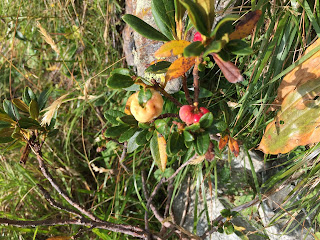
 Left: Carlina with butterflies. Center left: Campanula barbarta – Bearded Bellflower (Campanula barbata). Center right: Exobasidium rhododendri on Rhododendron ferrugineum. Right: Gentianella germanica – Chiltern Gentian (Genzianella tedesca). I was surprised to see a flowers with four and five petals on the same plant. Open question: a plant with all flowers of four petals would then be G. campestris.
Left: Carlina with butterflies. Center left: Campanula barbarta – Bearded Bellflower (Campanula barbata). Center right: Exobasidium rhododendri on Rhododendron ferrugineum. Right: Gentianella germanica – Chiltern Gentian (Genzianella tedesca). I was surprised to see a flowers with four and five petals on the same plant. Open question: a plant with all flowers of four petals would then be G. campestris.



 Left and center left: Hieracium intybaceum – Whitish Hawkweed (Sparviere cicoriaceo). Center right: Leucanthemopsis alpina – Alpine Moon Daisy (Margherita alpina). Right: Rumex alpinus – Munk’s Rhubarb, Alpine Dock (Romice acetosella) on Sentiero 203.
Left and center left: Hieracium intybaceum – Whitish Hawkweed (Sparviere cicoriaceo). Center right: Leucanthemopsis alpina – Alpine Moon Daisy (Margherita alpina). Right: Rumex alpinus – Munk’s Rhubarb, Alpine Dock (Romice acetosella) on Sentiero 203.


 Photos of chamoix above Foppolo. Left: A chamois scurries away near Lago Moro. Center: A chamois making its way down to Lago Moro from Corno Stella. Right: Mother and baby chamois going down to Lago Moro.
Photos of chamoix above Foppolo. Left: A chamois scurries away near Lago Moro. Center: A chamois making its way down to Lago Moro from Corno Stella. Right: Mother and baby chamois going down to Lago Moro.


 Walking around Lago Moro. Left: Above Lago Moro. Center: Walking from Rifugio Montebello to Lago Moro. Right: Heading back to Rifugio Montebello on Sentiero 203.
Walking around Lago Moro. Left: Above Lago Moro. Center: Walking from Rifugio Montebello to Lago Moro. Right: Heading back to Rifugio Montebello on Sentiero 203.



 Left and center left: Lunch at Rifugio Montebello, polenta and slow-cooked beef, pizzoccheri (pasta of buckwheat), and chocolate cake. Center right: Signs at bottom of ski slope pointing the way up to Rifugio Montebello and Lago Moro. Right: Walking on part of Corno Stella above Lago Moro.
Left and center left: Lunch at Rifugio Montebello, polenta and slow-cooked beef, pizzoccheri (pasta of buckwheat), and chocolate cake. Center right: Signs at bottom of ski slope pointing the way up to Rifugio Montebello and Lago Moro. Right: Walking on part of Corno Stella above Lago Moro.
 Starting the climb up Corno Stella.
Starting the climb up Corno Stella.



![[Asteraceae] Hieracium intybaceum – Whitish Hawkweed (Italiao: Sparviere cicoriaceo). [Asteraceae] Hieracium intybaceum – Whitish Hawkweed (Italiao: Sparviere cicoriaceo).](https://blogger.googleusercontent.com/img/b/R29vZ2xl/AVvXsEgVdvjvaopFh97BsJxs_w_Tb67ILW3h3LPG_ek_iaAolsgWbhCO2HWblrBvtuc5PcF_P5jyLcUwn6ISksudKnRJweJ9G4xo5EbosOsaItml9zl3BYBwYakp5LfV7yk4Tk545v6HTK29qQ/s400/Hieracium+intybaceum+1.jpg)
![[Asteraceae] Hieracium intybaceum – Whitish Hawkweed (Italiao: Sparviere cicoriaceo). [Asteraceae] Hieracium intybaceum – Whitish Hawkweed (Italiao: Sparviere cicoriaceo).](https://blogger.googleusercontent.com/img/b/R29vZ2xl/AVvXsEhyKVNvH6EeAus1FsnL6u4Kx1odyuTlRkbWhdf9v7XynrSNJKcHSA_9Mp45cvw3ozUT6h9-Y1eNkyOA2MPh2nXMF3lsYW13gtMT57dwi65BYXuTnHjHlyjO95TGAek2u1EyM-7p1ro9AQ/s400/Hieracium+intybaceum+2.jpg)
![[Campanulaceae] Phyteuma sp. [Campanulaceae] Phyteuma sp.](https://blogger.googleusercontent.com/img/b/R29vZ2xl/AVvXsEjEqLwglrE0Ka-MI3LHBkSS9bOFXlm0JFJgnxaNvlAqYw0Zw05TKAdthMcBhwb32k8VQ2UiRcdUsEM5bZ4GYZ0E94KxUzxWKSkCcPB_7dy075jR8aUADkDRoDGyWB4soHs_K7_hJ_SQRw/s400/Phyteuma.jpg)



